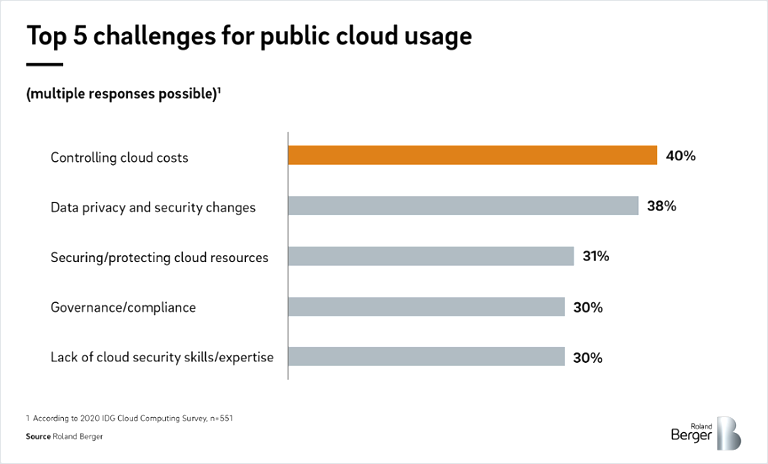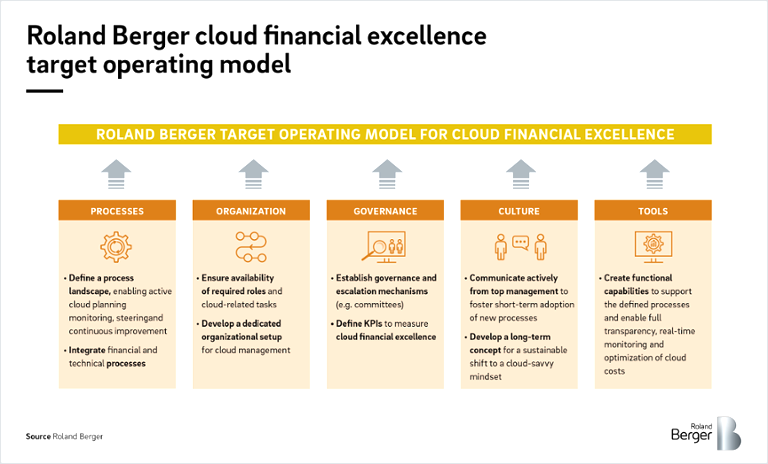Many manufacturers have difficulty implementing cloud-based solutions in their production environment. But for those that do, the benefits are far-reaching.


Maintaining cost control in cloud operations
How cloud financial excellence can ensure cost-efficiency without sacrificing quality
Public cloud services can offer numerous benefits, including increased flexibility, scalability and speed of innovation. However, cost control can be a major challenge. To achieve cloud financial excellence, organizations must make changes across the business, from processes and governance to culture and tools.

"Cloud services present IT teams with completely new cost responsibilities – fail to manage them correctly and spending can quickly rise."
Cloud operations have grown rapidly in recent years: Between 2019 and 2021, spend in public cloud services rose approximately 50%. By 2025, cloud spending is expected to exceed that of traditional, non-cloud IT infrastructure.
There’s good reason for this – cloud technology can deliver numerous benefits to almost any organization. A virtual, on-demand setup could provide greater flexibility and reduced costs, for example, as well as increased speed of innovation. Rapid scalability can accommodate shifts in demand almost instantly.
But the shift to cloud services can also pose a major cost-control challenge for businesses. In 2020, 80% of organizations were expected to overshoot their infrastructure-as-a-service budgets due to insufficient governance and misguided spending commitments.
Why cloud infrastructure can increase costs
There are several fundamental differences between an on-premise IT infrastructure and one hosted in the cloud. This may sound obvious but it’s not to be underestimated. Cloud services present both IT and business teams with completely new cost responsibilities – fail to manage them correctly and spending can quickly rise.
We see three main drivers behind a potential increase in operating costs when shifting to a cloud infrastructure.
- Procurement cycles shift from CAPEX to OPEX
An on-premise setup typically has long procurement cycles for physical infrastructure, resulting in CAPEX and fututre depreciations. But with cloud services, operators can book, scale or turn off resources almost instantly, generating OPEX. If not managed correctly, this shift can lead to increased costs. - Procurement shifts to IT
In non-cloud models, IT teams usually have to request resources, which must then be approved by a finance department. But with cloud models, IT users have instant access to a variety of services they can purchase without approval. This reduces cost control and visibility for finance teams. - Users don't adapt
Even after switching to the cloud, users and/or requesters of cloud resources still often expect the same sort of tailored services they received in a physical setup instead of matching their requests with the service provider’s standard options.
"By working together closely on data-driven spending decisions, IT, finance and business teams can generate maximum business value from cloud services."
The solution: Cloud financial excellence
So, how can you control costs when migrating to the cloud? Collaboration is crucial. By working together closely on data-driven spending decisions, IT, finance and business teams can generate maximum business value from cloud services.
Three key factors underpin a system of ‘cloud financial excellence’.
Firstly, cloud costs must be transparent. Processing data on cost and consumption as quickly as possible (preferably daily) enables real-time planning and monitoring. Costs should be broken down to an application level or even service levels per application, where possible.
Accountability for costs should be spread across an organization to each application owner. By clearly defining targets and constantly tracking progress, you can deploy countermeasures if costs run too high.
Lastly, strive for continual optimization. The variable cost model of cloud infrastructure allows teams to adjust their use in near real time.
Creating a sustainable model for success
Roland Berger’s operational model for cloud financial excellence concentrates on creating a sustainable mindset across an organization – one that focuses on maximizing cost-efficiency without sacrificing quality.
To do this, we consider five key areas: processes, organization, governance, culture, and tools. Measures range from defining a full process landscape or performance KPIs, to setting up cloud management teams and implementing communication campaigns (see infographic for more details).
Timeframes for implementation and success vary from business to business. Quick wins can often be achieved by working with IT on a resource utilization analysis, before immediately optimizing areas with the highest waste creation. We frequently see organizations with utilization rates below 10% for certain services due to incorrect sizing or simply forgetting to shut down inactive resources. Improving usage rates can bring immediate savings of 10-15% on total cloud costs. Other changes will take longer to reap benefits but can be just as effective, if not more so, achieving savings of 20% or more.
Register now to download the full publication on how cloud financial excellence can maximize cost-efficiency without sacrificing quality.











